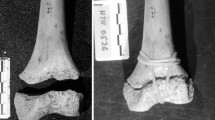Abstract
The purpose of this study is to describe an imaging method for identifying and characterising physeal growth arrest following physeal plate aggression. The authors describe the use of three-dimensional MRI performed with fat-suppressed three-dimensional spoiled gradient-recalled echo sequences followed by manual image reconstruction to create a 3D model of the physeal plate. This retrospective series reports the analysis of 33 bony physeal bridges in 28 children (mean age 10.5 years) with the use of fat-suppressed three-dimensional spoiled gradient-recalled echo imaging and 3D reconstructions from the source images. 3D reconstructions were obtained after the outlining was done manually on each source image. Files of all patients were reviewed for clinical data at the time of MRI, type of injury, age at MRI and bone bridge characteristics on reconstructions. Twenty-one (63%) of the 33 bridges were post-traumatic and were mostly situated in the lower extremities (19/21). The distal tibia was involved in 66% (14/21) of the cases. Bridges due to causes other than trauma were located in the lower extremities in 10/12 cases, and the distal femur represented 60% of these cases. Of the 28 patients, five presented with two bridges involving two different growth plates making a total of 33 physeal bone bars. The location and shape of each bridge was accurately identified in each patient, and in post-traumatic cases, 89% of bone bars were of Ogden type III (central) or I (peripheral). Reconstructions were obtained in 15 min and are easy to interpret. Volumes of the physeal bone bridge(s) and of the remaining normal physis were calculated. The bone bridging represented less than 1% to 47% of the total physeal plate volume. The precise shape and location of the bridge can be visualised on the 3D reconstructions. This information is useful in the surgical management of these deformities; as for the eight patients who underwent bone bar resection, an excellent correspondence was found by the treating surgeon between the MRI 3D model and the per-operative findings. Accurate 3D mapping obtained after manual reconstruction can also visualise very small physeal plates and bridges such as in cases of finger physeal disorders. MR imaging with fat-suppressed three-dimensional spoiled gradient-recalled echo sequences can be used to identify patterns of physeal growth arrest. 3D reconstructions can be obtained from the manual outlining of source images to provide an accurate representation of the bony bridge that can be a guide during surgical management.









Similar content being viewed by others
References
Ogden JA (1987) The evaluation and treatment of partial physeal arrest. J Bone Joint Surg Am 69:1297–1301
Peterson HA (1984) Partial growth plate arrest and its treatment. J Pediatr Orthop 4:246–258
Ogden JA (1990) Injury to the growth mechanisms. In: Ogden JA (ed) Skeletal injury in the child, 2nd edn. Saunders, Philadelphia, pp 97–173
Craig JG, Cramer KE, Cody DD et al (1999) Premature partial closure and other deformities of the growth plate: MR imaging and three-dimensional modelling. Radiology 210:835–843
Bright RW (1982) Partial growth arrest: identification, classification, and results of treatment. Orthop Trans 6:65–66
Langenskiöld A (1981) Surgical treatment of partial closure of the growth plate. J Pediatr Orthop 1:3–11
Williamson RV, Staheli LT (1990) Partial physeal growth arrest: treatment by bridge resection and fat interposition. J Pediatr Orthop 10:769–776
Mallet J (1975) Les épiphysiodèses partielles traumatiques de l’extrémité inférieure du tibia chez l’enfant. Leur traitement avec désépiphysiodèse. Rev Chir Orthop Reparatrice Appar Mot 61:5–16
Klassen RA, Peterson HA (1982) The physeal bar resection: the Mayo Clinic experience 1968–1978. Orthop Trans 6:65
Bollini G, Tallet JM, Jacquemier M et al (1990) New procedure to remove a centrally located bone bar. J Pediatr Orthop 10:662–666
Bracq H, Chapuis M (1990) Les désépiphysiodèses. In: Clavert JM, Metaizeau JP (eds) Les fractures des membres chez l’enfant. Sauramps Medical, Montpellier, pp 409–418
Carlson WO, Wenger DR (1984) A mapping method to prepare for surgical excision of a partial physeal arrest. J Pediatr Orthop 4:232–238
Lohman M, Kivisaari A, Vehmas T et al (2002) MRI in the assessment of growth arrest. Pediatr Radiol 32:41–45
Murray K, Nixon GW (1988) Epiphyseal growth plate: evaluation with modified coronal CT. Radiology 166:263–265
Porat S, Nyska M, Nyska A et al (1987) Assessment of bony bridge by computed tomography: experimental model in the rabbit and clinical application. J Pediatr Orthop 7:155–160
Loder RT, Swinford AE, Kuhns LR (1997) The use of helical computed tomographic scan to access bony physeal bridges. J Pediatr Orthop 17:356–359
Borsa JJ, Peterson HA, Ehman RL (1996) MR imaging of physeal bars. Radiology 199:683–687
Jaramillo D, Hoffer FA, Shapiro F et al (1990) MR imaging of fractures of the growth plate. Am J Roentgenol 155:1261–1265
Synder M, Harcke HT (1994) Evaluation of physeal behaviour in response to epiphyseodesis with the use of serial magnetic resonance imaging. J Bone Joint Surg Am 76:224–229
Ecklund K, Jaramillo D (2002) Patterns of premature physeal arrest: MR imaging of 111 children. Am J Roentgenol 178:967–972
Author information
Authors and Affiliations
Corresponding author
Rights and permissions
About this article
Cite this article
Sailhan, F., Chotel, F., Guibal, AL. et al. Three-dimensional MR imaging in the assessment of physeal growth arrest. Eur Radiol 14, 1600–1608 (2004). https://doi.org/10.1007/s00330-004-2319-z
Received:
Revised:
Accepted:
Published:
Issue Date:
DOI: https://doi.org/10.1007/s00330-004-2319-z




